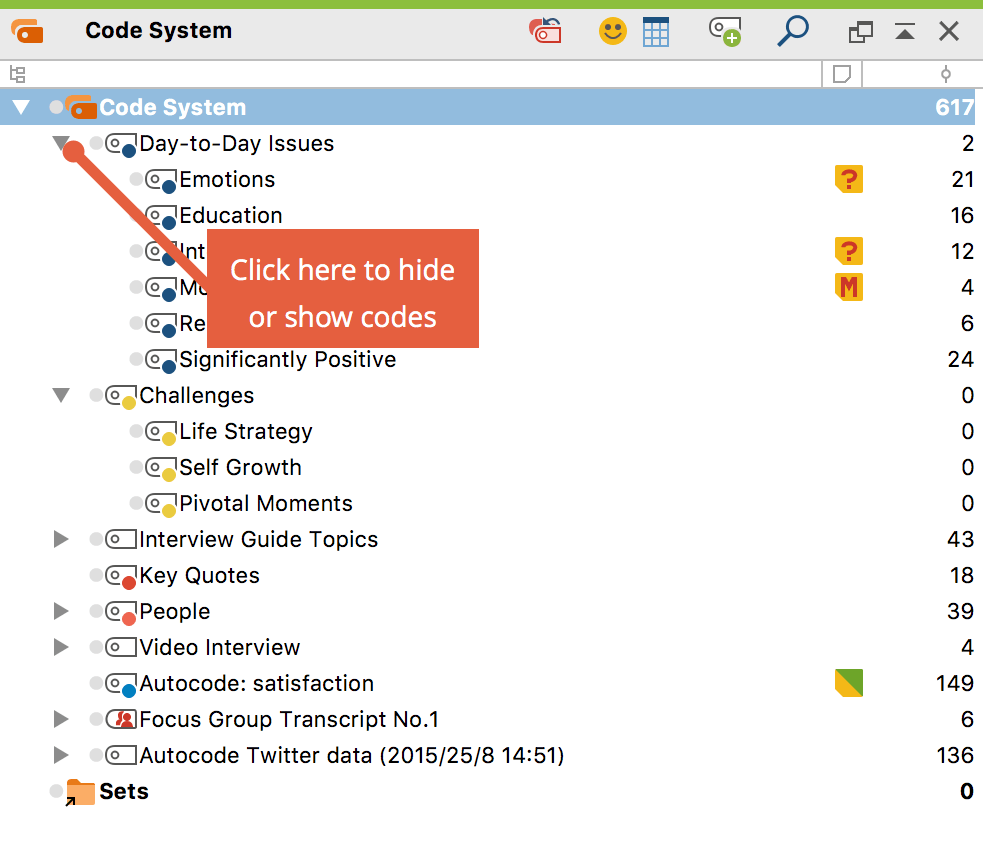Codes have a hierarchical structure, meaning you can create multiple subcodes, followed by subcodes of subcodes. All of the codes are shown in the “Code System” window.
At the beginning of a project, this window is empty except for the “Code System” and “Sets” icons and their associated icons.
MAXQDA’s “Code System” has the following characteristics:
- A code is a text with a maximum of 63 characters consisting of one or more words. A code can contain empty spaces and special characters.
- The number of codes in unlimited.
- The hierarchical structure can contain up to ten levels.
- Codes can be assigned a color.
- The so-called color codes play a special role. They are like text markers and change the background color of the marked text.
- emoticodes also play a specific role. An emoticon symbol appears in the “Code System” in the place of the code symbol, with pre-defined names that can be changed.
- Beginning with MAXQDA 12, there are also special codes for the participants of a focus group. These codes can be identified by this icon
 . These codes can perform special functions.
. These codes can perform special functions.
Working with coded segments (of text and images) and the “Code System” is a central aspect of computer-supported analysis. This work is usually not done automatically by the software, but rather is controlled by the researcher, although this often requires a significant amount of time. The “Code System” is shown as a tree structure on the screen. It looks like the file/folder system in Windows Explorer or Mac Finder with which you are likely familiar. A plus or minus sign before the code name indicates whether or not a code contains subcodes. You can expand or close the sub-categories by clicking this button.

You can click on the triangle symbol before the code to reveal or hide its subcodes.
Using MAXMaps you can build a network structure of codes to be used during the coding process, meaning you can code selected segments within a document and code them by dragging them onto a code in the network map.
The “Code System” toolbar
The following frequently-used functions for codes can be selected in the toolbar at the top of the "Code System" window:
![]() Reset activations – resets current code activations.
Reset activations – resets current code activations.
![]() Display emoticodes only /
Display emoticodes only / ![]() Display codes and emoticodes – reduces the display in the “Code System” window to emoticodes.
Display codes and emoticodes – reduces the display in the “Code System” window to emoticodes.
![]() Change to table view /
Change to table view / ![]() Change to standard view – switches between tree view, and table view of the code system.
Change to standard view – switches between tree view, and table view of the code system.
![]() New code – adds new code into the code system.
New code – adds new code into the code system.
![]() Display search toolbar – allows you to search for a specific code.
Display search toolbar – allows you to search for a specific code.
![]() Undock window
Undock window
![]() Maximize window
Maximize window
![]() Hide window
Hide window
In addition to using the toolbar to access functions in the “Code System,” you can also use the context menus that appear when you right-click on various icons in the window (e.g. on a code or the “Code System” icon, etc.).
